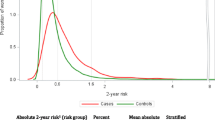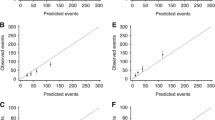Abstract
Purpose
A breast cancer risk prediction rule previously developed by Rosner and Colditz has reasonable predictive ability. We developed a re-fitted version of this model, based on more than twice as many cases now including women up to age 85, and further extended it to a model that distinguished risk factor prediction of tumors with different estrogen/progesterone receptor status.
Methods
We compared the calibration and discriminatory ability of the original, the re-fitted, and the type-specific models. Evaluation used data from the Nurses’ Health Study during the period 1980–2008, when 4384 incident invasive breast cancers occurred over 1.5 million person-years. Model development used two-thirds of study subjects and validation used one-third.
Results
Predicted risks in the validation sample from the original and re-fitted models were highly correlated (ρ = 0.93), but several parameters, notably those related to use of menopausal hormone therapy and age, had different estimates. The re-fitted model was well-calibrated and had an overall C-statistic of 0.65. The extended, type-specific model identified several risk factors with varying associations with occurrence of tumors of different receptor status. However, this extended model relative to the prediction of any breast cancer did not meaningfully reclassify women who developed breast cancer to higher risk categories, nor women remaining cancer free to lower risk categories.
Conclusions
The re-fitted Rosner-Colditz model has applicability to risk prediction in women up to age 85, and its discrimination is not improved by consideration of varying associations across tumor subtypes.

Similar content being viewed by others
References
Gail MH, Brinton LA, Byar DP, Corle DK, Green SB, Shairer C, Mulvihill JJ (1989) Projecting individualized probabilities of developing breast cancer for white females who are being examined annually. J Natl Cancer Inst 81:1879–1886
Costantino JP, Gail MH, Pee D, Anderson S, Redmond CK, Benichou J, Wieand HS (1999) Validation studies for models projecting the risk of invasive and total breast cancer incidence. J Natl Cancer Inst 91:1541–1548
Gail MH, Costantino JP, Pee D, Bondy M, Newman L, Selvan M, Anderson GL, Malone KE, Marchbanks PA, McCaskill-Stevens W, Norman SA, Simon MS, Spirtas R, Ursin G, Bernstein L (2007) Projecting individualized absolute invasive breast cancer risk in African American women. J Natl Cancer Inst 99(23):1782–1792
Matsuno RK, Costantino JP, Ziegler RG, Anderson GL, Li H, Pee D, Gail MH (2011) Projecting individualized absolute invasive breast cancer risk in asian and pacific islander american women. JNCI 103:951–961
Division of cancer epidemiology and genetics. Breast cancer risk assessment macro BrCa_RAM.sas. Downloaded from http://dceg.cancer.gov/tools/risk-assessment/bcrasasmacro
Rosner B, Colditz GA (1996) Nurses’ health study: log-incidence mathematical model of breast cancer incidence. J Natl Cancer Inst 88:359–364
Colditz GA, Rosner B (2000) Cumulative risk of breast cancer to age 70 years according to risk factor status: data from the nurses’ health study. Am J Epidemiol 152:950–964
Colditz GA, Rosner BA, Chen WY, Holmes MD, Hankinson SE (2004) Risk factors for breast cancer according to estrogen and progesterone receptor status. J Natl Cancer Inst 96:218–228
Rockhill B, Spiegelman D, Byrne C, Hunter DJ, Colditz GA et al (2001) Validation of the Gail model of breast cancer risk prediction and implications for chemoprevention. J Natl Cancer Inst 93(5):358–366
Boyle P, Mezzetti M, La Vecchia C, Franceschi S, Decarli A, Robertson C (2004) Contribution of three components to individual cancer risk predicting breast cancer risk in Italy. Eur J Cancer Prev 13:183–191
Tyrer J, Duffy SW, Cuzick J (2004) A breast cancer prediction model incorporating familial and personal risk factors. Stat Med 23:1111–1130
Boyd NF, Guo H, Martin LJ, Sun L, Stone J, Fishell E, Jong RA, Hislop G, Chiarelli A, Minkin S, Yaffe MJ (2007) Mammographic density and the risk and detection of breast cancer. N Engl J Med 356:227–236
Barlow WE, White E, Ballard-Barbash R, Vacek PM, Titus-Ernstoff L, Carney PA, Tice JA, Buist DS, Geller BM, Rosenberg R, Yankaskas BC, Kerlikowske K (2006) Prospective breast cancer risk prediction model for women undergoing screening mammography. J Natl Cancer Inst 98:1204–1214
Tice JA, Cummings SR, Smith-Bindman R, Ichikawa L, Barlow WE, Kerlikowske K (2008) Using clinical factors and mammographic breast density to estimate breast cancer risk: development and validation of a new predictive model. Ann Intern Med 148:337–347
Mavaddat N, Pharoah PD, Michailidou K et al (2015) Prediction of breast cancer risk based on profiling with common genetic variants. J Natl Cancer Inst. doi:10.1093/jnci/djv036
Pharoah PD, Antoniou AC, Easton DF, Ponder BA (2008) Polygenes, risk prediction, and targeted prevention of breast cancer. N Engl J Med 358:2796–2803
Tamimi RM, Rosner B, Colditz GA (2010) Evaluation of a breast cancer risk prediction model expanded to include category of prior benign breast disease lesion. Cancer 116:4944–4953
Meads C, Ahmed I, Riley RD (2012) A systematic review of breast cancer incidence risk prediction models with meta-analysis of their performance. Breast Cancer Res Treat 132:365–377
Visvanathan K, Hurley P, Bantug E, Brown P, Col NF, Cuzick J, Davidson NE, Decensi A, Fabian C, Ford L, Garber J, Katapodi M, Kramer B, Morrow M, Parker B, Runowicz C, Vogel VG 3rd, Wade JL, Lippman SM (2013) Breast cancer follow-up and management after primary treatment: American Society of clinical oncology clinical practice guideline update. J Clin Oncol 31:2942–2962
Colditz GA, Hankinson SE (2005) The nurses’ health study: lifestyle and health among women. Nat Rev Cancer 5:388–396
Rosner B, Glynn RJ, Tamimi RM, Chen WY, Colditz GA, Willett WC, Hankinson SE (2013) Breast cancer risk prediction with heterogeneous risk profiles according to breast cancer tumor markers. Am J Epidemiol 178:296–308
Hefti MM, Hu R, Knoblauch NW, Collins LC, Haibe-Kains B, Tamimi RM, Beck AH (2013) Estrogen receptor negative/progesterone receptor positive breast cancer is not a reproducible subtype. Breast Cancer Res 15:R68
Prentice RL, Gloeckler LA (1978) Regression analysis of grouped survival data with application to breast cancer data. Biometrics 34(1):57–67
Wu M, Ware JH (1979) On the use of repeated measurements in regression analysis with dichotomous responses. Biometrics 35(2):513–521
D’Agostino RB, Lee ML, Belanger AJ, Cupples LA, Anderson K, Kannel WB (1990) Relation of pooled logistic regression to time dependent Cox regression analysis: the framingham heart study. Stat Med 9(12):1501–1515
Glynn RJ, Rosner B (2004) Methods to evaluate risks for composite end points and their individual components. J Clin Epidemiol 57:113–122
Kerr KF, Wang Z, Janes H, McClelland RL, Psaty BM, Pepe MS (2014) Net reclassification indices for evaluating risk prediction instruments: a critical review. Epidemiology. 25:114–121
Shieh Y, Hu D, Ma L, Huntsman S, Gard CC, Leung JW, Tice JA, Vachon CM, Cummings SR, Kerlikowske K, Ziv E (2016) Breast cancer risk prediction using a clinical risk model and polygenic risk score. Breast Cancer Res Treat 159:513–525
Vachon CM, Pankratz VS, Scott CG, Haeberle L, Ziv E, Jensen MR, Brandt KR, Whaley DH, Olson JE, Heusinger K, Hack CC, Jud SM, Beckmann MW, Schulz-Wendtland R, Tice JA, Norman AD, Cunningham JM, Purrington KS, Easton DF, Sellers TA, Kerlikowske K, Fasching PA, Couch FJ (2015) The contributions of breast density and common genetic variation to breast cancer risk. J Natl Cancer Inst. doi:10.1093/jnci/dju397
Tworoger SS, Zhang X, Eliassen AH, Qian J, Colditz GA, Willett WC, Rosner BA, Kraft P, Hankinson SE (2014) Inclusion of endogenous hormone levels in risk prediction models of postmenopausal breast cancer. J Clin Oncol 32:3111–3117
Steinkellner AR, Denison SE, Eldridge SL, Lenzi LL, Chen W, Bowlin SJ (2012) A decade of postmenopausal hormone therapy prescribing in the United States: long-term effects of the women’s health initiative. Menopause 19:616–621
Rosner BA, Colditz GA, Hankinson SE, Sullivan-Halley J, Lacey JV Jr, Bernstein L (2013) Validation of Rosner-Colditz breast cancer incidence model using an independent data set, the California teachers study. Breast Cancer Res Treat 142:187–202
Hosmer DW, Lemeshow S (2000) Applied logistic regression, 2nd edn. Wiley, New York
Funding
This project was funded by a cohort infrastructure Grant (UM1 CA186107), and a program project Grant (P01 CA87969) from the National Cancer Institute.
Author information
Authors and Affiliations
Corresponding author
Ethics declarations
Conflict of interest
The authors declare that they have no conflict of interest.
Rights and permissions
About this article
Cite this article
Glynn, R.J., Colditz, G.A., Tamimi, R.M. et al. Extensions of the Rosner-Colditz breast cancer prediction model to include older women and type-specific predicted risk. Breast Cancer Res Treat 165, 215–223 (2017). https://doi.org/10.1007/s10549-017-4319-0
Received:
Accepted:
Published:
Issue Date:
DOI: https://doi.org/10.1007/s10549-017-4319-0




